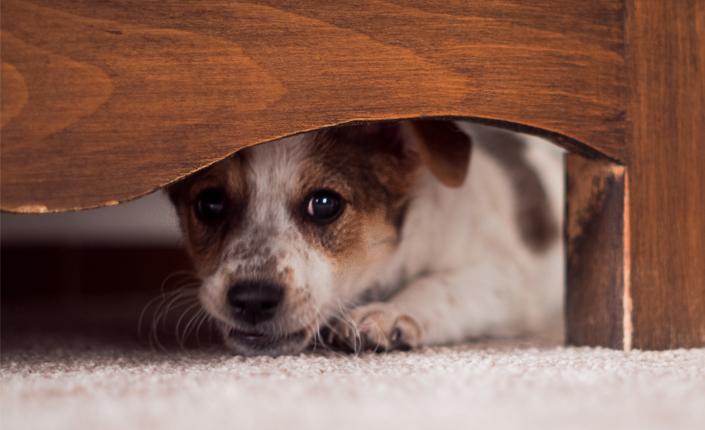
Sound Effects: How To Help Pets With Noise Phobias
If the roar of a thunderstorm or the crackling of fireworks sends your pet into an anxious frenzy, this article is for you.
Noise Phobia, also known as Noise Anxiety, is a fear of sounds. Pets may become so stressed that they tremble, hide, or bark in fright. If your dog or cat suffers from separation anxiety, there’s a good chance they have a noise phobia too.
Thunderstorms and fireworks are often the most triggering, but even the sound of a household appliance can cause a pet’s anxiety to flare up. Fireworks are often associated with a holiday or event, which makes it easier to prepare a strategy for minimizing pet anxiety ahead of time. Thunderstorms on the other hand are unpredictable.
So, what’s the best way to help the noise-phobic pet? Keep reading to find out!
Let the Music Play
There’s a variety of music CDs for pets that slowly introduce scary sounds underneath the main track. The calming music will distract them, so they won’t listen too closely to the noises in the background. The trick is to train your dog to passively listen rather than actively listen to the offending sounds. As your pet becomes more comfortable passively listening to those frightening noises, their anxiety will lessen. Playing music or leaving the TV on are also good strategies for blocking out a scary sound.
Keep Calm
Dogs feed off of your own energy. They’ll sense if you’re getting a little anxious about a thunderstorm too. Try to maintain a calm demeanour in these stressful situations and use positive reinforcement when your pets settle down on their own. A positive attitude can make a world of difference for your pet!
Carry On
If their anxiety appears minimal (i.e. your pet becomes startled, but can quickly recover), ignoring your pet until they quiet down is a possible strategy.
Some pet experts warn that too much reassurance when your pet is in a hysterical state can actually make the anxiety worse. Your pet could interpret your reassurance as a sign that their panicked response is actually a good reaction that you are encouraging. It may seem cruel but keeping a steady and calm demeanour is really the best way to go.
Safe Space
Create a safe haven for your pet to retreat to when their fear sets in. Dogs love a “den” or a crate. Fill the space with their toys and bedding to make it a cozy hiding spot. Cats often seek shelter in a box, carrier, or even under the couch. Smaller animals may prefer a space with lots of blankets that they can burrow into. Once your pet has found their spot, leave them be. Trying to move them once they’ve found their safe space may cause their anxiety to worsen.
Protect Your Pet
Shelters often take in the most lost pets in the days after a major fireworks display. This is where a microchip really proves its value. In the event your pet does manage to run away out of fear, the microchip offers a greater chance of your pet being found and returned to you.
Vet Intervention
Extreme cases of anxiety will require a visit to the vet. There are also prescription medications and natural treatments for anxiety that can be effective when paired with other strategies for managing noise. Your vet may even recommend using a pheromone spray or diffuser to calm your dog.
Overcoming a fear is never easy, but as long as you support your pet, you’ll be able to weather any storm together!
